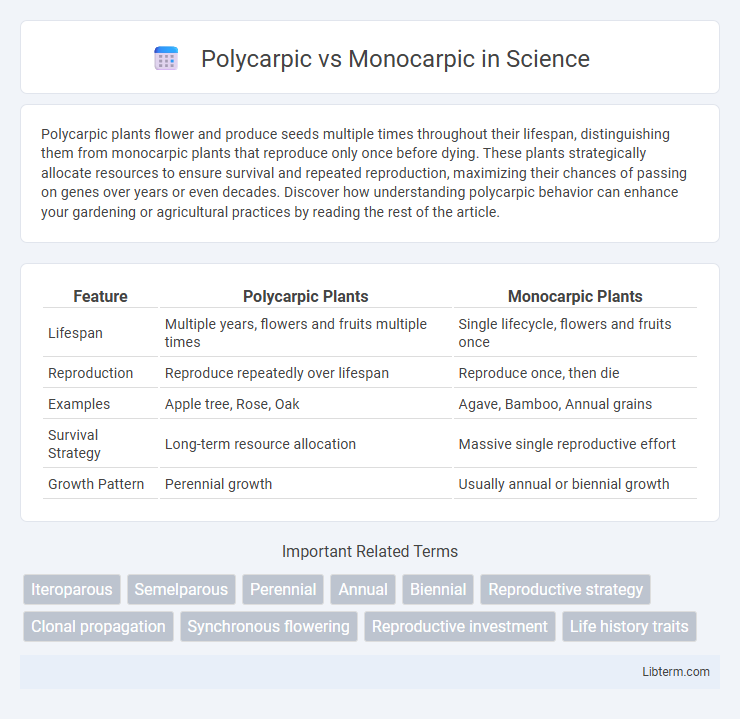Polycarpic plants flower and produce seeds multiple times throughout their lifespan, distinguishing them from monocarpic plants that reproduce only once before dying. These plants strategically allocate resources to ensure survival and repeated reproduction, maximizing their chances of passing on genes over years or even decades. Discover how understanding polycarpic behavior can enhance your gardening or agricultural practices by reading the rest of the article.
Table of Comparison
| Feature | Polycarpic Plants | Monocarpic Plants |
|---|---|---|
| Lifespan | Multiple years, flowers and fruits multiple times | Single lifecycle, flowers and fruits once |
| Reproduction | Reproduce repeatedly over lifespan | Reproduce once, then die |
| Examples | Apple tree, Rose, Oak | Agave, Bamboo, Annual grains |
| Survival Strategy | Long-term resource allocation | Massive single reproductive effort |
| Growth Pattern | Perennial growth | Usually annual or biennial growth |
Introduction to Polycarpic and Monocarpic Plants
Polycarpic plants flower and fruit multiple times throughout their lifespan, enabling extended reproductive success across seasons. Monocarpic plants complete their life cycle by flowering once, then producing seeds before dying, often investing significant energy in a single reproductive event. Understanding the distinctions between polycarpic and monocarpic growth strategies is crucial for advancing agricultural practices and plant breeding programs.
Defining Polycarpy and Monocarpy
Polycarpy refers to plants that flower and fruit multiple times throughout their lifespan, enabling repeated reproductive cycles and prolonged seed production. Monocarpy describes plants that flower once, produce seeds, and then die, completing their reproductive process in a single event. These reproductive strategies influence plant life history traits and ecological adaptations in various species.
Life Cycle Differences
Polycarpic plants flower and produce seeds multiple times throughout their life cycle, allowing for repeated reproductive cycles over several years. Monocarpic plants undergo a single reproductive event before completing their life cycle, often dying shortly after seed production. This fundamental difference affects strategies for survival and resource allocation in varying environments.
Evolutionary Significance
Polycarpic plants, which flower and fruit multiple times throughout their lifespan, exhibit evolutionary significance by maximizing reproductive opportunities across varying environmental conditions, enhancing resilience and genetic diversity. In contrast, monocarpic plants invest all resources into a single reproductive event, often leading to large seed dispersal, which can be advantageous in unpredictable or transient habitats. These differing strategies reflect adaptive responses to ecological pressures, shaping plant survival and fitness across diverse ecosystems.
Reproductive Strategies
Polycarpic plants reproduce multiple times over their lifespan, producing flowers and seeds each season, maximizing reproductive output and genetic diversity. Monocarpic plants invest all their energy into a single reproductive event before dying, optimizing resource allocation for one large seed production to ensure species survival. These contrasting reproductive strategies reflect evolutionary adaptations to environmental stability and resource availability.
Examples of Polycarpic Species
Polycarpic species, such as apple trees (Malus domestica), oak trees (Quercus spp.), and strawberry plants (Fragaria x ananassa), flower and fruit multiple times throughout their lifespan, enabling repeated reproductive cycles. Unlike monocarpic plants like bamboo or agave that flower once and then die, polycarpic species invest in long-term growth and recurrent seed production. This adaptation enhances their survival and genetic propagation across diverse environmental conditions.
Examples of Monocarpic Species
Monocarpic species such as bamboo, agave, and certain species of palm exemplify plants that flower, set seed once, and then die. These plants invest significant energy into a single reproductive event, often leading to mass flowering phenomena like bamboo flowering every several decades. In contrast, polycarpic species such as apple trees and roses flower multiple times throughout their lifespan, ensuring continuous reproductive cycles.
Ecological Implications
Polycarpic plants, which flower and fruit multiple times during their lifespan, contribute to ecosystem stability by providing consistent resources for pollinators and seed dispersers, enhancing biodiversity. Monocarpic plants, flowering once before dying, often dominate disturbance-prone habitats by producing large seed banks that enable rapid colonization and succession. These reproductive strategies influence population dynamics, habitat resilience, and community structure across various ecological systems.
Agricultural and Horticultural Relevance
Polycarpic plants, such as apple trees and strawberries, produce flowers and fruits multiple times throughout their lifespan, offering sustained yield and reducing replanting costs in agriculture and horticulture. Monocarpic plants, including wheat and bamboo, flower once before dying, often providing a single, large harvest useful for annual crop production and biomass accumulation. Understanding these reproductive strategies aids farmers and horticulturists in crop selection, harvest timing, and resource allocation to maximize productivity and sustainability.
Conclusion and Future Perspectives
Polycarpic plants, which flower and fruit multiple times during their lifespan, demonstrate greater resilience and adaptability compared to monocarpic plants that flower once before dying. Future research could focus on genetically enhancing monocarpic species to extend their reproductive cycles or improve biomass production, potentially benefiting agricultural yield and sustainability. Understanding the molecular mechanisms underlying these reproductive strategies offers opportunities for crop improvement and enhanced ecological management.
Polycarpic Infographic

 libterm.com
libterm.com